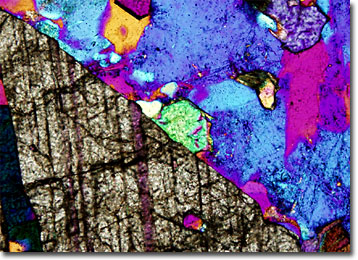Polarized Light Microscopy Digital Image Gallery
Diorite Gneiss
Diorite is a crystalline igneous rock that exhibits a granular texture and is sometimes alternatively referred to as black granite. The rock is primarily comprised of plagioclase feldspar, but generally contains smaller amounts of biotite, hornblende, or other dark-colored minerals as well.

View a second image of Diorite Gneiss
A medium- to coarse-grained metamorphic rock, gneiss exhibits alternating light and dark bands, which is a characteristic usually caused by the separation of mafic and felsic minerals. However, despite their foliated appearance, gneiss does not exhibit the well-developed cleavage and schistosity that is found among schists. The light bands of the rock are typically composed of quartz and feldspar, but the composition of the dark bands fluctuates considerably. Variable in a number of other regards as well, gneisses are often classified based upon a number of attributes, including parent material, chemical composition, and probable formation process, resulting in descriptors such as diorite gneiss, diopside gneiss, and orthogneiss.
Diorite gneiss chiefly consists of sodium-rich plagioclase feldspar, quartz, and hornblende, as well as minor amounts of biotite, sphene, or other accessory minerals. Depending on the exact mineral constituents and their relative abundance, the rock may exhibit an overall light or dark appearance, though all varieties exhibit the distinct banding effect characteristic of gneiss. When polished, diorite gneiss displays a good luster, resulting in its heavy use for sculptures in ancient Egypt, where significant quantities of the stone could be found. In fact one of the most famous and spectacular sculptures from that civilization, a large statue of Khafre, a king of the fourth dynasty that built the second of the three Pyramids of Giza, is composed of the material.
